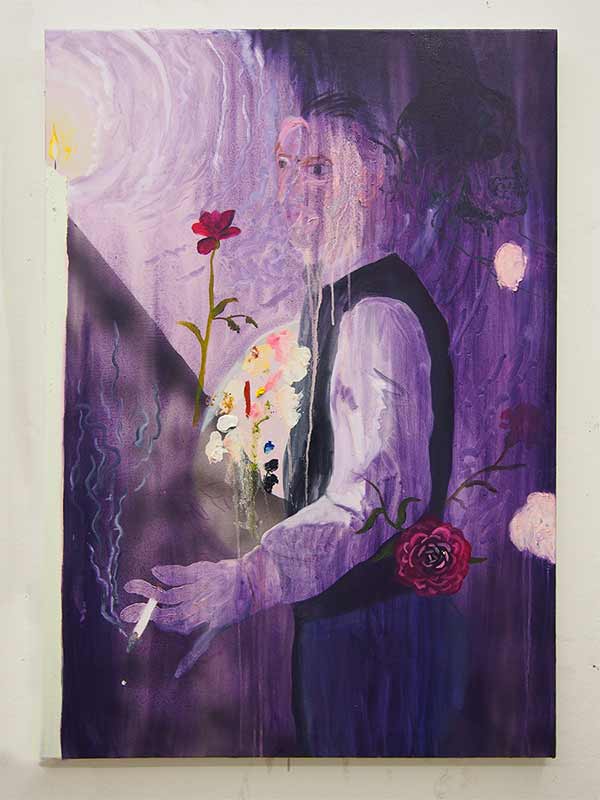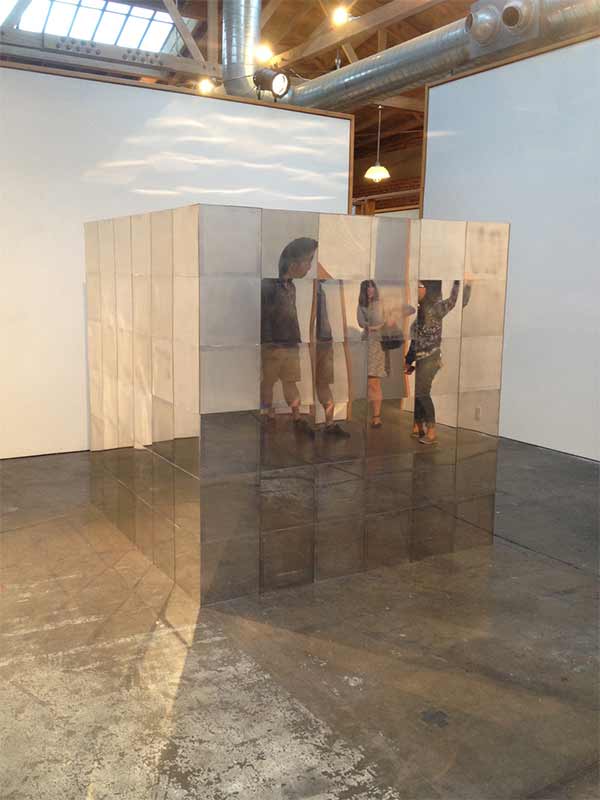UC San Diego ‘Revolutionizes’ Annual Symposium and Open Studios
Published Date
By:
- Sheena Ghanbari
Share This:
Article Content

M.F.A. candidate Morgan Mandalay’s, Portrait of a Painting as Self-Portrait, 2016. Photo: Morgan Mandalay.
The UC San Diego Department of Visual Arts is hosting, Local Revolutions: the Ninth-Annual Ph.D. Symposium and Open Studios, Sat. March 5 with events happening at the Visual Arts Presentation Lab (SME 149), Pepper Canyon Hall and throughout the Visual Arts Facility (VAF). This year’s symposium, 9:00 a.m. to 5:00 p.m., features keynote speaker Lucy R. Lippard, a renowned writer, activist and curator who has published several books about contemporary art and cultural studies. Open Studios runs from 2:00 to 7:00 p.m. in the VAF and features more than 30 artist studios alongside group exhibitions, performances and film screenings.
A unique element in this year’s Open Studios is the collaboration with the Museum of Contemporary Art, San Diego, and its Assistant Curator Anthony Graham. The joint project was sparked through a conversation between Graham and M.F.A. candidate Morgan Mandalay. Graham agreed to conduct studio visits with graduate student artists and selected works that have a certain multiplicity. Based on his visits, Graham curated New Things Are More, which will be presented in the VAF Graduate Gallery.
The events comprising Local Revolutions are designed to bridge the campus and local arts community. Graduate students Noni Brynjolson and Paloma Checa-Gismero co-organized this year’s symposium portion around the themes of community-based art, cultural activism and the ideology of space.
“We were interested in coming up with ideas for the symposium that would provoke discussions around art and social change, both in terms of contemporary art practices and historical understandings of revolutionary art,” said Brynjolson.
Aligned with those themes, Lippard’s presentation, scheduled for 3:30 p.m., is entitled, “Critical Landscape Photography in the Changing West: A Local Revolution? Or not?” It will focus on representations of landscape and how they connect with various forms of social change. In addition to Lippard’s keynote address, Local Revolutions also includes three graduate-student panels that explore the role of art in various local processes with an emphasis on cities, institutions and activism.
M.F.A. candidate Erika Ostrander, who helped plan the last two Open Studios, notes the vibrancy present.

M.F.A. candidate Erika Ostrander’s, From The Middle of The Cloud, I Call Your Name, Installation, 2014. Photo: Space4Art, San Diego.
“I love the energy at Open Studios; VAF feels like it comes alive. Open Studios always seems like a release valve for the department,” she said. “It is a time when we can hit the pause button on being consumed by our own making and research and be present in sharing our spaces with the public.”
According to Ostrander, Open Studios is a collective effort between M.F.A. candidates and Ph.D. art practice students.
“We really work as a group to make an event that exemplifies community and support while highlighting our diverse practices. We strive to create a welcoming environment for anyone who is interested in getting a glimpse into the work generated by the Department of Visual Arts,” she said.
Additionally, Open Studios features collaborations with artists and writers on campus, highlighting the crossovers between the visual and linguistics.
“The inception of the Department of Visual Arts developed alongside experimental writing practices, epitomized in the work of founding visual arts faculty member David Antin. The symbiotic relationship can still be seen in the work of faculty of both departments, and with the founding of the M.F.A. Writing Program less than a decade ago, this relationship has only gotten stronger,” said Mandalay.
Besides the exhibitions, there is a film component to this year’s event. M.F.A. candidate Amy Reid organized Screen Time, a continuous loop of films that will be presented in the Visual Arts Performance space. The multi-layered programming provides an array of prospects for interested visitors and is a formative experience for visual arts graduate students.
Local Revolutions is possible with support from the Women’s Center, Center for Global Justice; Graduate Student Association; Office of Equity, Diversity and Inclusion; and FIELD, an initiative to develop new research methodologies and new forms of criticism and analysis appropriate to collaborative, participatory and socially engaged art practice. Open Studios is possible with support from the Division of Arts and Humanities, the Graduate Student Association and KPBS.
The UC San Diego Department of Visual Arts is ranked 13th in the nation for fine arts, according to U.S. News & World Report, with high-ranking specialties in multimedia and sculpture. For more information and the full schedule for Local Revolutions, visit the website.
Share This:
You May Also Like
Stay in the Know
Keep up with all the latest from UC San Diego. Subscribe to the newsletter today.



